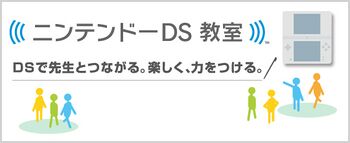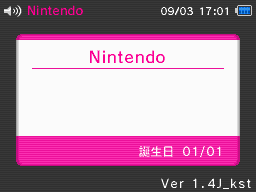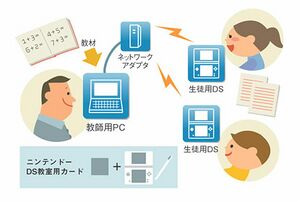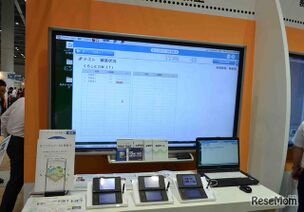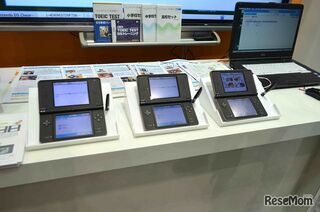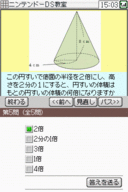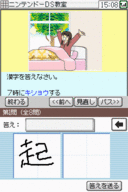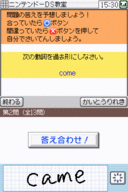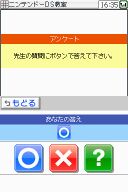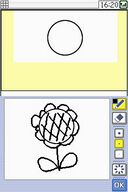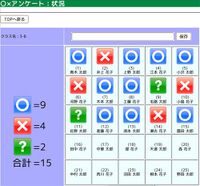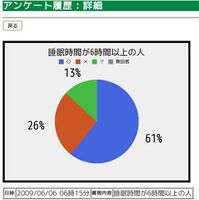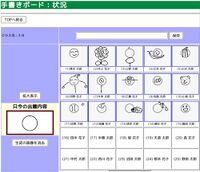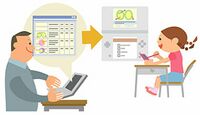Nintendo DS Classroom
TODO:
- DSi icon rips.
- Gallery.
- Missing archive links (including images).
- One of the specific images shows in great detail what the PC software offers.
- Kyoshitsu Argumented Reality Test.
Nintendo DS Classroom (ニンテンドーDS教室) is an educational system developed by Nintendo and Sharp System Products, utilizing the Nintendo DSi LL (known as the Nintendo DSi XL internationally) for students to use as a learning device during class. The program was available exclusively in Japan and rolled out between January and April 2010.
Contents
Overview
Contents
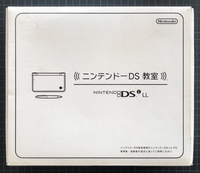
Nintendo DS Classroom units are shipped in white boxes, illustrating the Nintendo DSi LL with the Nintendo DS Classroom's logo. Inside the box is the unit itself with a white/grey color scheme, a thick plastic pen and a power supply. On the back of the unit is a giant sticker with legal information.
The PC software likely would've been distributed digitally.
Nintendo DS Software
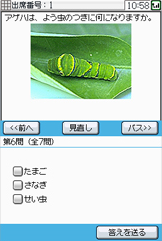
The primary application for getting work exercises done is through the Nintendo DS Classroom application (ニンテンドーDSきょうしつ). The application uses a modified version of Nintendo Zone and relies on a PC with the DS Classroom software that is connected over the same network. 50 consoles can be connected to one network simultaneously. Once connected, a student can follow several different courses or tests set up by their teacher.
On a Nintendo DSi, a student can partake in live tasks and tests that are set up by their teacher. Different kinds of questions can be asked, such as yes/no surveys using O, X and ? symbols, or picking answers from a list. Additionally, they can send drawings through a drawing board and have these display on a teacher's PC. Students can also work individually through preset tasks and create their own memorization cards. Once a unit is disconnected, all data is lost[3].
PC Software
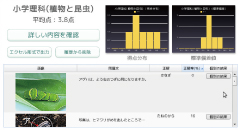
On a PC, a teacher can make use a large selection of materials provided by the software. Additionally, they can create and modify materials with the use of spreadsheet software, such as Microsoft Excel. At the end of a task or test, student results are shown and saved with detailed graphs [3].
This PC software was developed both for Windows and various Linux distributions, including Ubuntu. As of writing, the software hasn't resurfaced.
Console Software
The software bundled on every classroom Nintendo DSi LL is different compared to a retail unit.
- The System Settings displays a unique version number of v1.4_kst, with "kst" possibly being a shortened variation of "kyoshitsu" (キョウシツ), which translates to "classroom". This system software version was used throughout the program's lifespan.
- The Nintendo DSi Shop and Nintendo Zone are not installed. Because of this, Data Management isn't accessible from the System Settings.
- A different lineup of DSiWare is pre-installed.
| Icon | Name | Title ID | Version | Pre-installed On Retail Consoles | |
|---|---|---|---|---|---|
| Japanese | English | ||||
Nintendo |
Nintendo |
00030004 4b50454a | 0 | No | |
らくびきじてん Nintendo |
Rakubiki Jiten Nintendo |
00030004 4b44344a | 1 | Yes | |
えいわ らくびきじてん Nintendo |
Eiwa Rakubiki Jiten Nintendo |
00030004 4b44334a | 0 | No | |
わえい らくびきじてん Nintendo |
Waei Rakubiki Jiten Nintendo |
00030004 4b44354a | 0 | No | |
Nintendo |
Nintendo |
00030004 484e474a | 3 | Yes | |
Nintendo |
Nintendo |
00030004 4b47554a | 2 | Yes | |
Note that Flipnote Studio had several revisions in Japan. Classroom units come with version 2.1 pre-installed.
Development
Development started somewhere around 2007, with the project lead by Takao Sawano, challenging himself to make use of open source software. Seeing how many schools were using the Nintendo DS in schools, the goal was to see how many Nintendo DSs could connect wirelessly to cheap laptops. Sometime later, Sharp System Products was offered to help with the development of applications.[4]
The system was announced in a press release by Nintendo on June 9th, 2009 alongside the announcement of a partnership with Sharp System Products. At this point, Nintendo planned to offer educational software for all Nintendo DS systems, with Sharp being responsible for developing software and selling the program. Software would be released individually as cartridges, with 30 titles planned for elementary school, 20 titles for junior high school and 10 for high school with an estimated release date of February 2010. The program was showcased at the New Education Expo 2009 in Osaka from June 17th to June 18th and e-Learning WORLD in Tokyo from August 5th to August 7th[5].
On August 5th, 2009, Sharp put out an update announcing that the program switched to only use the Nintendo DSi. Reasons for the switch include that the Nintendo DSi could be more easily customized, software could be stored on the console itself, the DSi Camera could be used for certain activities, communication over the internet is easier, and the DSi has a larger screen compared to the Nintendo DS or Nintendo DS Lite [6].
Sometime before the program was rolled out, the system was changed to make use of the Nintendo DSi LL, which was released a few months prior. Regular Nintendo DSi development units were used very late during testing, as apparent by development kits that showed up on Yahoo! Auctions in 2023, identified as units K04 to K08[K 1][K 2][K 3][K 4][K 5].
Gallery
EDIX 2012
The program was shown at the Educational IT Solution Expo (教育ITソリューションEXPO) in 2012 at Sharp's booth, demonstrating Nintendo's offers for educational software, and showcasing that Nintendo DS Classroom could run on cheap, inexpensive computer hardware[7].
Sharp Website
2009 Press Release (Prerelease)
These materials were shared in the official press release, and does not reflect what the final version of the application looks like.
Sourced from Nintendo[5], ITMedia[8] and GamingTalker[9].
Links
References
- ↑ Nintendo DSi LL Classroom Unit (Consolevariations) (Archive)
- ↑ 対応教材 (Sharp System Products) (Archived)
- ↑ 3.0 3.1 3.2 機能紹介 (Sharp System Products) (Archived)
- ↑ Touch de Oboeru Hyakuninisshu: Chotto DSi Shiguredono (Nintendo) (Archive)
- ↑ 5.0 5.1 授業支援システム『ニンテンドーDS教室』について (Nintendo) (Archive)
- ↑ 授業支援システム『ニンテンドーDS教室』の 仕様変更についてのお知らせ (Sharp System Products) (Archived)
- ↑ 【EDIX】シャープの「ニンテンドーDS教室」、学生がすぐに利用できる操作性に着目
- ↑ 任天堂、授業支援システム「ニンテンドーDS教室」を開発 (ITMedia)
- ↑ Cos'era Nintendo DS Classroom (GamingTalker)
Yahoo! Auction listings:
- ↑ [K04] https://page.auctions.yahoo.co.jp/jp/auction/k1093738420
- ↑ [K05] https://page.auctions.yahoo.co.jp/jp/auction/o1095340951
- ↑ [K06] https://page.auctions.yahoo.co.jp/jp/auction/w1094656443
- ↑ [K07] https://page.auctions.yahoo.co.jp/jp/auction/g1093013416
- ↑ [K08] https://page.auctions.yahoo.co.jp/jp/auction/x1093733075
